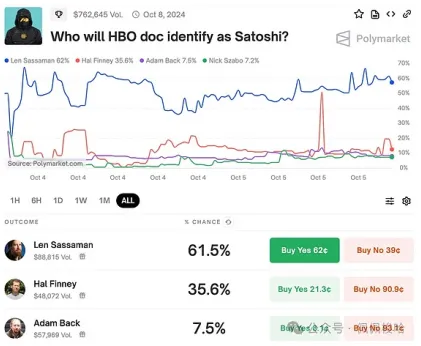Perhaps it is precisely because Bitcoin has achieved a de-Satoshi-ization that it has developed to this day.
Written by: Jessy, Golden Finance
"Who is Satoshi Nakamoto?" — This may be the biggest mystery in the history of the development of the crypto world.
In the past two years, discussions about who Satoshi Nakamoto is have cooled down. Within the Bitcoin community, the development of the Bitcoin ecosystem and technological advancements are more important matters. Who Satoshi is may not be significant; after all, since Satoshi's disappearance, Bitcoin has been running smoothly under the maintenance of its core development team.
However, every so often, someone will bring up the topic of searching for Satoshi, or claim to be Satoshi themselves. This time, HBO in the United States released a documentary titled "Money Electric: The Bitcoin Mystery," which identifies Bitcoin core developer Peter Todd as Satoshi Nakamoto. This conclusion has been treated as a joke within the crypto community, and Peter Todd himself denied this conclusion on X.
From the traces left by Satoshi Nakamoto on the internet from 2008 to 2011, it can be seen that Satoshi is a cryptography geek who is meticulous in his actions and encrypts all communications, never revealing personal information.
Who exactly is Satoshi Nakamoto? Perhaps only someone who can transfer the wallet assets containing over a million Bitcoins can prove it, but the real Satoshi wants to remain hidden. Perhaps it is precisely because Bitcoin has achieved a de-Satoshi-ization that it has developed to this day.
We Are All Satoshi
In "Money Electric: The Bitcoin Mystery," the director used a lot of footage to showcase the activities of a group of long-time Bitcoin believers. The documentary not only introduces what these core figures around Bitcoin have done but also shows what companies surrounding Bitcoin, such as Blockstream, which is dedicated to promoting the adoption of Bitcoin by individuals, companies, and even nations, have accomplished.
Moreover, the film presents some significant events in the development of cryptocurrency, such as the block size debate, the rise of Ethereum and altcoins, and some regulatory actions by the U.S. government.
The storytelling level of the documentary is adequate, connecting personal stories to vividly explain Bitcoin and the crypto culture behind it, as well as its historical development.
The documentary also has another narrative thread, which is a major gimmick in its external promotion: the search for who Satoshi Nakamoto is. The documentary uses arguments to lock the final answer onto Bitcoin core developer Peter Todd. At the end of the documentary, the director confronts Peter Todd, who awkwardly smiles at the camera and says, "We are all Satoshi."
Peter Todd, a Canadian, is 39 years old and is a heavyweight developer and cryptographic consultant for Bitcoin Core. According to records, Peter Todd first submitted Bitcoin core code in April 2012.
People in the crypto industry find the answer to the question "Who is Satoshi Nakamoto?" given by the documentary to be a joke. Peter Todd himself also denied on X that he is Satoshi.
The documentary's efforts in searching for Satoshi may be misguided; it can only be considered a side story in the development of the crypto industry. However, the exploration of who Satoshi is has never ceased over the years, with journalists searching and some individuals stepping forward to claim they are Satoshi themselves.
So what kind of person is Satoshi Nakamoto? He insists on using PGP encryption and the Tor network when communicating with anyone in the crypto community. The information left online that can verify his identity includes Satoshi claiming to be Japanese; using British English in written expression; having a writing style similar to some cryptographic peers; displaying a routine based on Greenwich Mean Time; and using an email address on a free email server in Germany, among others. It seems these are just deliberate clues left by Satoshi to hide his identity.
Yet people attempt to analyze who Satoshi is based on these traces. For example, some believe that Japanese mathematician Shinichi Mochizuki is Satoshi, mainly because he is Japanese. Another person considered to be Satoshi is Dorian Nakamoto. Additionally, the late cryptographer Len Sassaman is also thought by some to be Satoshi because he committed suicide in 2011, the same year Satoshi disappeared, and there is some overlap in their technical contributions. Another person widely considered a possibility is computer engineer and legal scholar Nick Szabo, who created the concept of smart contracts in a 1996 paper. In 2008, he proposed the concept of decentralized currency and published a paper on Bitcoin as digital gold, being regarded as a pioneer of Bitcoin, and he is also known for using pseudonyms.
Whether seeking evidence to prove or refute these claims about Satoshi, it is relatively easy. Ultimately, who Satoshi is does not matter for Bitcoin; what matters is that "we are all Satoshi."
Satoshi is not the authority of Bitcoin; it is "we," the ones running Bitcoin nodes, and "we," the ones using Bitcoin, who are responsible for Bitcoin.
Satoshi's Disappearance: The First Step Towards Decentralization
Satoshi not only created Bitcoin but also maintained and guided its development in the early years.
On April 26, 2011, U.S. time, Satoshi sent his last email to Bitcoin core developer Gavin Andresen (who was also Satoshi's most active assistant at the time) and clearly stated that he had "moved on to other things."
After that, Satoshi disappeared and never reappeared.
During the more than three years from 2008 to 2011, his main actions were as follows:
On November 1, 2008, Satoshi published the paper "Bitcoin: A Peer-to-Peer Electronic Cash System."
On January 3, 2009, Satoshi mined the Bitcoin genesis block, achieving the "mining" of the Bitcoin algorithm and receiving the first batch of 50 Bitcoins.
On December 5, 2010, the WikiLeaks incident occurred, where WikiLeaks was cut off from donation channels like credit cards. The Bitcoin community called for WikiLeaks to accept donations in Bitcoin. To protect the still-nascent Bitcoin, Satoshi appeared to oppose the community's donation of Bitcoin to WikiLeaks.
On December 12, 2010, Satoshi posted his last article on the Bitcoin forum and subsequently ceased public communication, only contacting a few members of the Bitcoin core development team via email.
On April 26, 2011, he had his last contact with Gavin Andresen via email.
Other details embedded in the history of Bitcoin's development show that in the early days, Satoshi, as the chief developer of Bitcoin, did a lot for Bitcoin but also essentially became a "dictator" in Bitcoin's development.
For example, Satoshi registered the website bitcoin.org on August 18, 2008, which is the original community forum for Bitcoin and an open-source project. Satoshi updated its code nearly 50 times in the first year. In August 2010, a code vulnerability appeared in Bitcoin, and many early developers tried to patch it, but ultimately, it was Satoshi who wrote and released the patch.
At that time, Satoshi was the gatekeeper of Bitcoin; all code had to be finalized by him. Due to some disagreements, users and developers began to challenge Satoshi's authority.
For instance, one of the hottest threads on the forum at the time was about "Can applications exist on top of Bitcoin?" Satoshi himself supported sidechains but faced significant opposition. Additionally, Satoshi had used a strategy rule called IsStandard to restrict the use of advanced commands, which also drew criticism from some.
It is evident that in the last year before Satoshi's departure, people's attitudes toward his leadership underwent a significant change.
The conclusion of the story about Satoshi and Bitcoin is that he removed his name from the copyright notice of Bitcoin. He updated Bitcoin.org, adding the names and emails of other developers on its contact page — including Gavin Andresen, Sirius, Laszlo, and Nils Schneider — and removed his name and email.
Later, on April 26, 2011, Satoshi sent two emails to Gavin Andresen, the last of which included a copy of the encryption key for the Bitcoin alert system, effectively giving Gavin Andresen sole control over security notifications. Subsequently, Gavin Andresen seemed to replace Satoshi as the chief developer of Bitcoin. In 2014, he also stepped back from Bitcoin software development to focus on his work with the Bitcoin Foundation, which he had created in 2012.
Currently, Bitcoin's development has largely achieved decentralization. The operational logic of the Bitcoin Core team, the most well-known technical team for Bitcoin, is such that anyone can operate a full node and contribute to Bitcoin by running the Bitcoin Core development software. This distribution of power prevents any single entity from controlling Bitcoin.
Bitcoin did not falter after Satoshi's departure; rather, Satoshi's disappearance was the first step in realizing Bitcoin's decentralization.
免责声明:本文章仅代表作者个人观点,不代表本平台的立场和观点。本文章仅供信息分享,不构成对任何人的任何投资建议。用户与作者之间的任何争议,与本平台无关。如网页中刊载的文章或图片涉及侵权,请提供相关的权利证明和身份证明发送邮件到support@aicoin.com,本平台相关工作人员将会进行核查。



